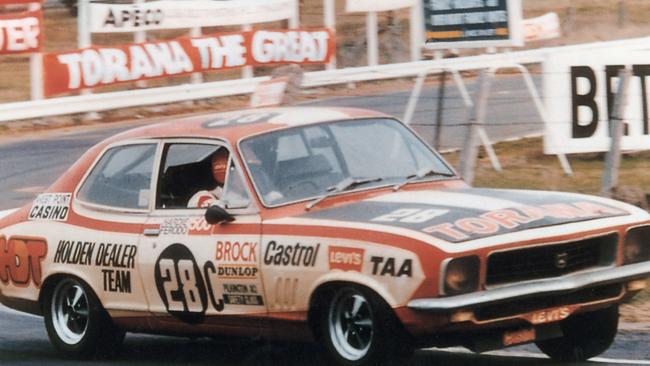Peter Brock: film celebrates the life of great racing car driver
An extraordinary new account of the life of Australia’s greatest racing driver sees some of Brock’s story aired for the first time.

Not only sports fans but those who have an abiding interest in both documentary as a form and great Australian stories will be interested in the ABC’s slate of sports films being broadcast over the next four weeks. They feature not only legends like Steve Waugh and Wayne Gardner but a fine film called Walkabout Wickets which follows the 2018 National Indigenous Cricket Teams on their tour of the UK. Compellingly, it is also the parallel story of how in 1868, a group of Aboriginal cricketers made a three-month journey from Australia to the UK by sea, playing 47 matches across the country.
First up though, is the adrenaline-driven Brock: Over the Top, an extraordinary account of the life of Australia’s greatest racing driver, Peter Brock, who died violently in a hairpin smash in 2006 driving a replica Shelby-Chevrolet north of Perth.
As this film dramatises so vividly he was the Messiah of Motor Sport, the bloke from rural Hurstbridge in Victoria who could get in anything and drive it.
He gathered many monikers including “Peter Perfect”, “The King of the Mountain”, or simply “Brocky”, and won nine titles in the Bathurst 1000, a race in Brock’s day that was like a religion to thousands, full of dust and drama, with no barriers between the cars and the acolytes, where if things went wrong, they did badly.
The documentary is from that seemingly indefatigable director and writer Kriv Stenders (Red Dog, Danger Close: The Battle Of Long Tan), and prolific producer Veronica Fury (Machete Maidens Unleashed!, Electric Boogaloo: The Wild, Untold Story of Cannon Films).
Fury developed the idea after the controversial 2016 Ten TV series also called Brock, which appeared to some critics to have been aimed at the superfans of the iconic driver and was somewhat short on biographical detail, even if it captured something of the high-octane aura of car racing. The “passionate outcry” from fans moved Fury, whose husband was an ardent Brock fan and had once won a custom modified red VE Commodore SS, known as Holden’s “King of the Jungle”, which became his obsession.
She could see a story that only documentary could tell, she says, a grand more accurate story originally aimed at the big screen.
“One that explored the man behind the legend – the deeper layers of Peter’s private life and tragic end,” she says in a production note.
“One that spoke to a broad audience, not just fans. One that encapsulated this universal and timeless tale – the hero’s epic journey – the soaring highs and dramatic lows – the heartbreaking tragedy and the enduring legacy.”
And now developed for the small screen, she and her director pull it off, a smashing tale of this iconic figure, a wonderful biography told at the kind of speed Brock lived his life.
“Bite off more than you can chew and then chew like hell,” was one of his mottos. And one of his colleagues describes his frenetic driving style as “dancing on the edge of the razor blade”.
In almost kaleidoscopic fashion under Stender’s direction, we experience not only the speedy highs of the cars and races but the depressive lows of his personal life.
It was as if, like the great racer Enzio Ferrari, he believed for much of his life, “what’s behind you doesn’t matter”.
There are the marriages, “the young girls of racing” as his long-time partner, the eternally loyal Bev calls them in the film, the accusations of abuse from his first wife, former Miss Australia Michelle Downes, the ugly, public split from investor and racing partner Holden and, of course, the farce that was the Energy Polariser.
This was the bizarre device involving crystal pieces and magnets attached to the engine of his racing car that Brock believed would realign and distribute energy, vastly improve performance and in fact “reinvent the law of physics”. Brock came under the influence of Dr Eric Bowker, known to those in Brock’s team, out of earshot, as “Doctor Feelgood”, who introduced him to crystal technology, the association leading to the giant destroying the underdog when Brock was divorced by the dealer, Holden.
By 1997 he had lost confidence, the physicality and mental acuity had diminished a little and partner Bev (who changed her name by deed poll to Brock, the couple having two children) says he fell “into an amazing hole”.
With a prominent role in Stender’s film, she speaks of his struggle to reconcile with his past mistakes towards the end of his life.
“Shortly before his death he heart wrenchingly apologised, telling me that he had made so many mistakes,” she says in a statement on the film, a sympathetic witness to his life until the end. “He believed he had failed us as a partner and father and had never achieved anything worthwhile. We, however, knew a man who was gentle and decent, a well-intentioned human being who sadly never quite managed to become the ideal he strived for. Sadly, he died trying to prove he still had it.”
The story is presented chronologically, following a brilliant pre-titles montage sequence dramatising the way he raced that concludes with an image of the car in which he died.
Stenders then develops his story with interviews providing the central narrative arc, into which editor Tania M. Nehme superbly splices a vast array of archival material, including personal home movies, photographs, and rare footage taken at Brock’s various races at Bathurst and internationally.

And Stenders enhances these two techniques using animated motion graphics, and the use of split-screens to highlight the sheer exhilaration and risk of Brock’s inimitable style of motor racing. One colleague of Brock’s says it was an approach epitomised by “strong heart and big balls”; others talk, still with wonder, of his uncanny ability to become one with a machine, tricking it to do whatever he wanted.
As some terrific home footage reveals, it was an obsession with speed that started when Brock, living at home with his younger brothers, obtains an Austin 7 motor car from a neighbour and strips it down using his mother’s axe.
Obsessed with ideas about the nature of mechanics from the start, he created a “paddock bomb”, after taking out the brakes and destroying the car’s body, bashing it around his parents’ farm whenever he could, learning what he called “mechanical sympathy,” enabling him to empathise with any vehicle.
His son James, a terrific interview subject, says “he raced cars as fast as he could, and did exactly what he wanted, whenever he wanted”.
Inspired by a visit to the Bathurst race in 1966, he somehow purchases an HD Holden, a Triumph Herald and an Austin 7A30, and ingeniously mechanically combines them into what becomes his famous A30 sports sedan, the little blue, unstable hybrid with the yellow stripes.
In this ungainly vehicle he wins 102 races, dicing with the best drivers and wrangling his homemade racer against the most sophisticated machinery. These are a couple of wonderfully visceral sequences captured in both home movies and footage grabbed at the tracks. The interviews are deliberately and intimately shot by Stender’s cinematographer Mark Broadbent in a studio against a pale neutral background, allowing Nehme to alter the size of the shots as the momentum of the narrative requires, a clever bit of post-production, and, as Stenders says, they “become a tapestry of commentary” in the absence of the conventional narrator to drive his story.
Some are raw, some uncomfortably direct, like the short interview with Michelle Downs: “If he hadn’t won a race, God help us.” And some are quite contradictory and in their own way suggest the complexities inherent in Stender’s narrative, an account that is no easy, fawning hagiography.

The archival documentary has fallen a little out of favour in recent years, those talking heads intercut with whatever old footage and photographs can be summoned up to illustrate the chat. But Stenders says he wanted to push the archival documentary film form to a new level, which he’s done by not simply developing a structural dramatic narrative balancing act with his various narrators but a visual one as well. This is high-level cinematic storytelling, Nehme’s work in the editing suite especially making something excitingly new out of the old.
In this way he’s created an unusually immersive and discerning feature with wide appeal, not merely to those who worshipped, and still do, The King of the Mountain.
Brock: Over The Top, Tuesday, ABC, 8.30pm.

